As a dog owner, you may have wondered why your furry friend yawns in your face. Yawning is not only a sign of tiredness but can also be a form of communication in dogs. Understanding the reasons behind your dog’s yawning behavior can help you better interpret their needs and emotions.
Yawning in dogs is a fascinating aspect of their behavior. It can serve various purposes, such as indicating tiredness, expressing anxiety or stress, or even conveying excitement. By paying attention to your dog’s yawns and considering the context in which they occur, you can gain valuable insights into their well-being.
Key Takeaways:
- Yawning is a form of dog body language and can be a way for dogs to communicate.
- Dogs may yawn when they’re tired, as a form of appeasement, or to alleviate stress.
- Yawning can have different meanings depending on the context, such as indicating fatigue, anxiety, confusion, or excitement.
- By observing your dog’s overall body language and considering other cues, such as eye contact and tail position, you can better understand their emotions and intentions.
- Building a strong bond and effective communication with your dog requires attentiveness to their yawning behavior and other forms of body language.
Yawning in Dogs: A Closer Look
When it comes to understanding our dogs, their body language can be a valuable tool. Yawning, a behavior we often associate with tiredness or boredom, holds deeper significance in the canine world. Yawning in dogs is not only a physical act but also a form of communication and expression. By delving into the nuances of dog yawning, we can gain valuable insights into their emotions and intentions.
Yawning in dogs closely resembles human yawning. It is characterized by a wide-open jaw, often accompanied by a deep breath. Some dogs may even emit a sound while yawning, while others do so silently. However, the purpose behind a dog’s yawn can vary. It can indicate tiredness, serve as a calming signal in stressful situations, or communicate appeasement.
To fully understand the meaning behind a dog’s yawn, it is important to pay attention to their overall body language. Dogs communicate through a combination of vocalizations, facial expressions, and body movements. By observing their eye contact, tail position, and ear position, we can decipher the true intent behind their yawns.
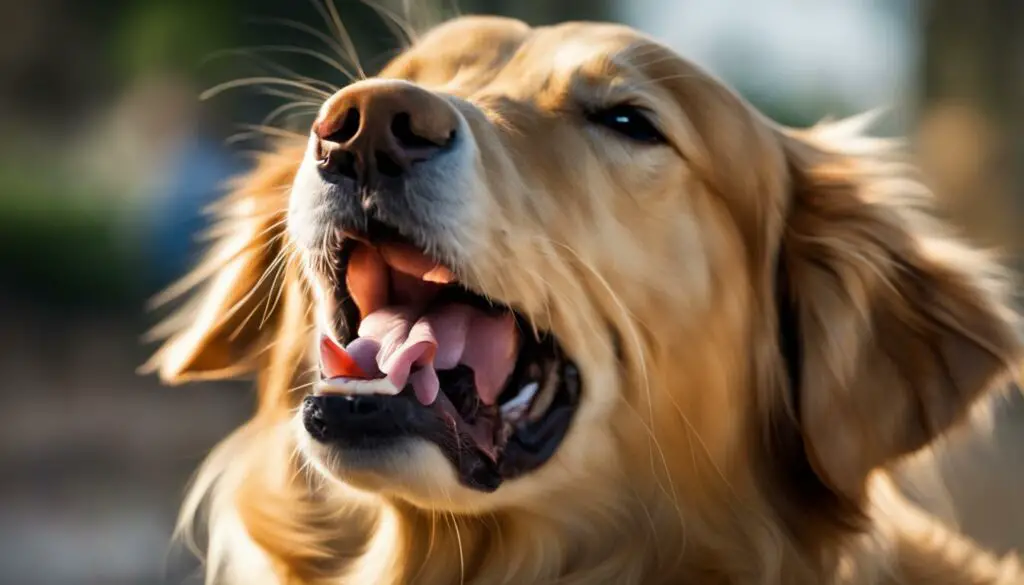
Interpreting your dog’s yawns is a holistic process that requires taking into account the context in which the yawning occurs. For example, if your dog yawns during a visit to the vet or during a thunderstorm, it may be a sign of anxiety or stress. Conversely, if your dog yawns before a walk or during playtime, it may indicate excitement and anticipation. By understanding the different meanings behind yawning in dogs, we can improve our communication and strengthen our bond with our furry friends.
Yawning as a Sign of Fatigue
Dogs often yawn when they’re tired, just like humans do. Yawning can be seen when a dog is waking up, falling asleep, or when they lay down. Other signs of fatigue may include relaxed sighing and sleepy eyes. When your dog yawns in these situations, it’s a clear signal that they need rest.
When we observe a tired dog, it’s crucial to provide them with a quiet and comfortable sleep space. This allows them to retreat and get the rest they need. A sleep space can be a designated area in your home where your dog feels safe and secure. Consider using a dog bed or a soft blanket to create a cozy spot for your furry friend.
Creating a calm environment is also important for promoting quality sleep in dogs. Minimizing noise and distractions, such as turning off the TV or closing curtains, can help your dog relax and fall asleep more easily. Remember, a well-rested dog is a happy dog!
Table: Signs of a Tired Dog
| Signs | Explanation |
|---|---|
| Yawning | Indicates fatigue and the need for rest |
| Relaxed sighing | Signifies relaxation and winding down |
| Sleepy eyes | Shows drowsiness and a desire for sleep |
Understanding your dog’s sleep signals can help you create a peaceful environment and ensure they get the rest they need. By respecting their need for sleep and providing a comfortable sleep space, you can contribute to their overall well-being and happiness.

Yawning as an Appeasement Gesture
Yawning in dogs is not only a sign of tiredness but also serves as an appeasement gesture, indicating their desire to avoid conflict or reduce anxiety. When a dog feels threatened or uncomfortable, they may yawn and avert their gaze, communicating their submissive and non-threatening intentions. This calming signal is a way for dogs to maintain peaceful interactions and diffuse tense situations.
Dogs may exhibit this appeasement yawning in various stressful situations, such as visits to the vet or during thunderstorms. It is essential for dog owners to recognize these signs of anxiety and create a safe and comforting environment for their canine companions. By understanding and respecting their dog’s need for calming signals, owners can help alleviate stress and promote a sense of security.
Examples of Calming Signals
Aside from yawning, dogs display other calming signals in their body language to communicate their desire to avoid conflict. These signals may include lip licking, turning their head or body away, and lowering their body posture. Recognizing and responding appropriately to these signals can prevent escalation of anxiety and aggression and foster a stronger bond between dogs and their owners.
| Calming Signal | Meaning |
|---|---|
| Yawning | Appeasement and stress reduction |
| Lip licking | Anxiety or discomfort |
| Head/body turning away | Avoiding confrontation |
| Lowered body posture | Submission and non-threatening behavior |
Understanding and respecting these calming signals is crucial for effective communication with dogs. By creating a safe and supportive environment, dog owners can help their canine companions feel more comfortable and reduce anxiety in their daily lives.
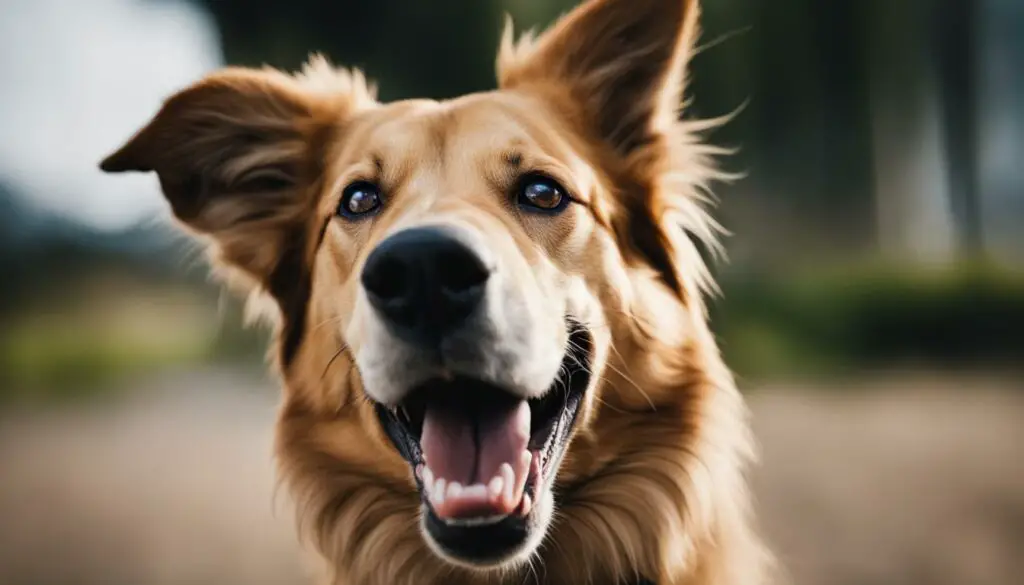
Yawning as a Sign of Stress
Yawning can be a sign that your dog is stressed. Dogs may yawn more often in stressful situations, such as during car rides or when exposed to loud noises. The yawns may be accompanied by panting and whining. It’s important to identify and address the sources of stress in your dog’s environment to help them feel more comfortable and reduce yawning behavior.
Stress in dogs can manifest in various ways, and yawning is one of the cues they use to communicate their discomfort. When a dog yawns in stressful situations, it’s a way for them to release tension and signal their unease. This behavior can occur when they are exposed to new environments, encountering unfamiliar people or animals, or during highly stimulating events.
To help your dog cope with stress, it’s important to create a calm and safe environment for them. Provide them with a designated space where they can retreat and relax when they feel overwhelmed. Additionally, introducing positive reinforcement techniques and engaging in calming activities such as gentle massage or interactive play can help alleviate stress and reduce yawning behavior.
| Signs of Stress in Dogs | Ways to Reduce Stress |
|---|---|
| Excessive yawning | Provide a quiet and safe space for your dog |
| Panting and whining | Use positive reinforcement techniques |
| Restlessness and pacing | Engage in calming activities such as massage or interactive play |
| Decreased appetite | Introduce gradual exposure to stressful stimuli |
By addressing your dog’s stress and providing them with the support they need, you can help reduce their yawning behavior and improve their overall well-being. Additionally, consulting with a professional dog trainer or a veterinarian specializing in behavior can provide further guidance and assistance in managing your dog’s stress.

Yawning and Sleep Space
Creating a calm and comfortable sleep environment for our dogs is essential for their overall well-being. Just like humans, dogs need a designated sleep space where they can retreat and relax without any disturbances or anxieties. Providing them with a quiet and safe area of their own can help promote better sleep quality and reduce yawning behavior related to sleep issues.

Dogs often yawn when they want to go to bed but cannot do so because someone is in their sleep space. They may yawn to communicate their desire for privacy and uninterrupted rest. By respecting their need for a dedicated sleep area, we can create a peaceful environment that promotes restful sleep and minimizes yawning during waking hours.
Creating the Perfect Sleep Space for Your Dog
When setting up a sleep space for your dog, consider their individual preferences and needs. Here are some tips to create a comfortable sleep environment:
- Choose a quiet and secluded area of your home where your dog can sleep undisturbed.
- Provide a cozy and comfortable dog bed or mat that suits the size and breed of your dog.
- Add soft blankets or pillows to make the sleep space inviting.
- Avoid placing the sleep space near noisy appliances or high-traffic areas.
- Ensure the sleep space is well-ventilated and at a comfortable temperature.
“Creating a serene sleep space for your dog can help alleviate sleep-related yawning and promote their overall well-being.”
Remember, dogs thrive on routine, so establishing a consistent sleep schedule can also contribute to better sleep quality. By implementing these strategies and providing a peaceful sleep space, you can help your dog get the rest they need and reduce yawning behavior associated with sleep deprivation or interrupted sleep.
Yawning and Anxiety Triggers
Yawning in dogs can be a sign of anxiety or stress. Understanding the triggers that cause anxiety in your dog is crucial for their well-being. By identifying and minimizing exposure to these triggers, you can help reduce your dog’s stress levels and minimize their yawning behavior.
Common anxiety triggers for dogs include witnessing conflict, being scolded, or being exposed to loud noises. These situations can create a sense of fear or unease for your pet, leading to increased yawning as a response. By creating a calm and supportive environment for your dog, you can help alleviate their anxiety and reduce yawning tendencies. This may include providing a safe and quiet space for your dog to retreat to, using positive reinforcement techniques in training, and avoiding situations that cause excessive stress.
Reducing Stress in Dogs
There are several strategies you can employ to help reduce stress in dogs and minimize yawning:
- Gradual desensitization: Gradually expose your dog to their anxiety triggers in a controlled and positive manner. This can help them build confidence and reduce their stress response.
- Counter-conditioning: Pairing the anxiety-triggering stimuli with positive experiences, such as treats or play, can help change your dog’s emotional association with those triggers, reducing their anxiety.
- Providing mental stimulation: Engaging your dog’s mind with puzzle toys, training exercises, and interactive play can help redirect their focus away from stressful situations and reduce overall anxiety.
- Seeking professional help: If your dog’s anxiety persists or worsens despite your efforts, it may be beneficial to consult with a professional dog trainer or behaviorist. They can provide tailored advice and strategies to address your dog’s specific anxiety triggers.
Remember, each dog is unique, and what triggers anxiety in one dog may not affect another. It’s important to observe your dog’s behavior closely and make adjustments based on their individual needs. By addressing their anxiety triggers and providing a supportive environment, you can help your dog feel more at ease and reduce their yawning behavior.
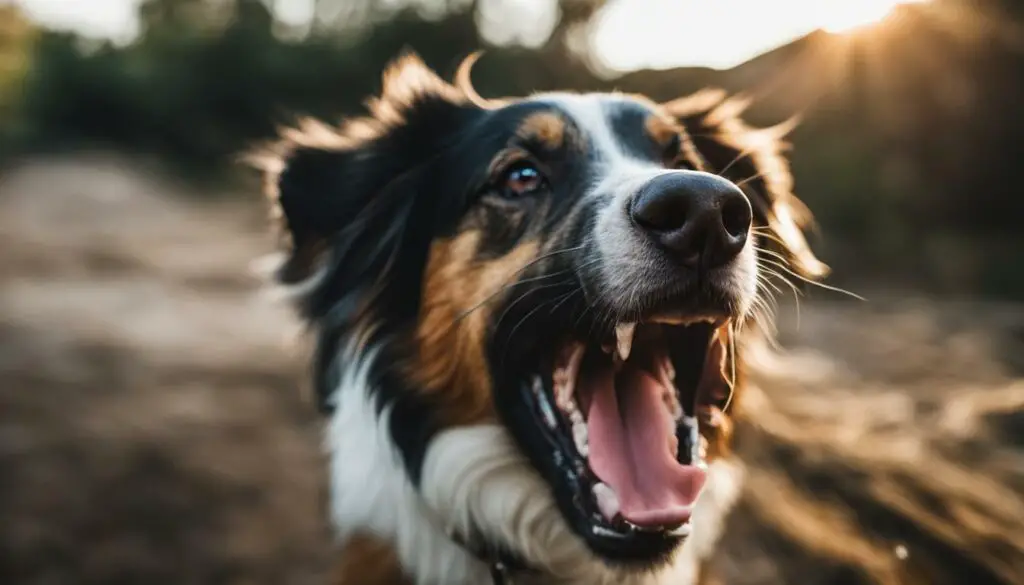
Yawning and Excitement
Yawning in dogs is not always a sign of tiredness or stress. In fact, it can also be an expression of excitement and anticipation. When your dog yawns before a walk or during playtime, it’s their way of showing enthusiasm for the upcoming activity.
During a yawn, dogs take in a deep breath, increasing oxygen flow and heart rate, preparing their bodies for action. It’s an instinctual response that helps them get ready for the fun and adventure that await them. So if your furry friend yawns in these situations, it’s a clear indication of their excitement and eagerness.
Interpreting your dog’s yawning behavior in the context of excitement can help you better understand their emotional state and enhance your bond. By recognizing their anticipation, you can provide them with engaging activities and experiences that fulfill their needs and bring them joy.
Remember, every dog is unique, and their body language may vary. Pay close attention to their other behaviors and cues, such as tail wagging, bouncing, or eagerly looking at you, to confirm their excitement. Together, you and your furry companion can embark on exciting adventures, creating lasting memories and strengthening your bond.
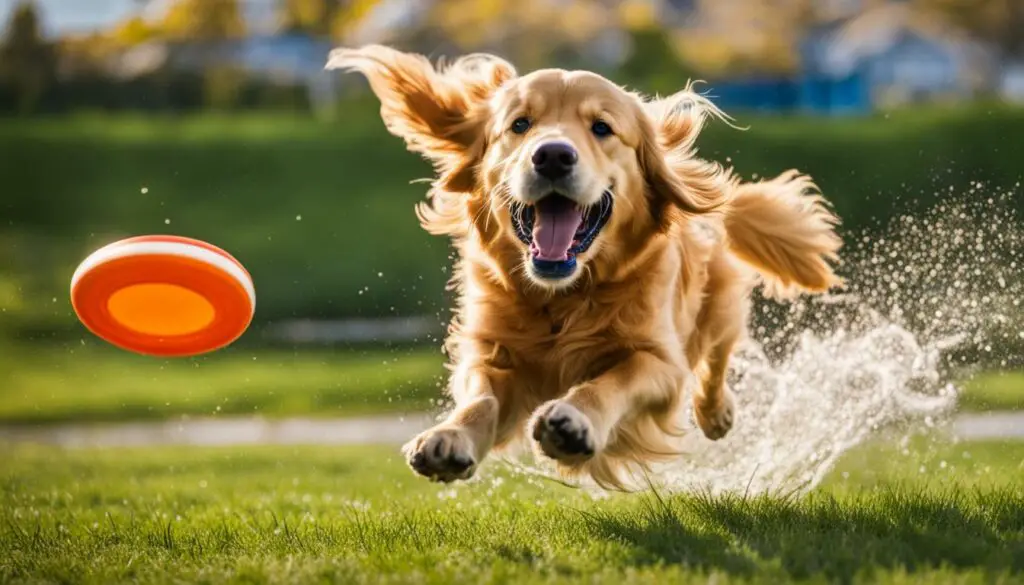
Table: Signs of Excitement in Dogs
| Behavior | Description |
|---|---|
| Tail wagging | A fast and enthusiastic wagging motion indicates excitement |
| Jumping or bouncing | Impulsive movements, such as jumping up and down or bouncing, show excitement |
| Play bow | The dog lowers their front body while keeping their hind end in the air, signaling playfulness and excitement |
| Alert and focused | The dog’s body language becomes attentive, with heightened senses and direct eye contact |
| Panting | Increased breathing and panting occur due to excitement and anticipation |
Yawning and Emotional Connection
Dogs have a remarkable ability to form deep emotional connections with their owners. One intriguing expression of this bond is when dogs yawn in response to their owners yawning. Studies have shown that dogs are more likely to yawn after observing their owners yawn compared to unfamiliar people. This suggests that dogs possess a level of empathy and emotional connection with their human companions.
This phenomenon of dogs yawning in response to their owners is a clear indication of the strong bond and emotional closeness they share. It demonstrates that dogs are sensitive to their owners’ emotions and can mirror their behavior. So, the next time you yawn and catch your furry friend yawning along with you, take it as a sign of their emotional connectivity and trust in your presence.
The Science Behind Dogs Yawning in Response to Owners
The exact mechanism behind dogs yawning in response to their owners is not fully understood, but it is believed to be associated with contagious yawning, a phenomenon commonly observed in humans. Contagious yawning is thought to be linked to the mirror neuron system, which plays a role in empathy and social bonding. Dogs may have a similar neural mechanism that allows them to mirror the behavior of their owners.
Yawning is a behavior that can be observed in various social contexts, such as when an individual is tired, stressed, or anxious. It is thought that dogs yawn in response to their owners as a way to communicate and show empathy. Yawning may serve as a calming signal, indicating that they understand and share the emotional state of their owners.
Overall, the fact that dogs yawn in response to their owners is a fascinating display of their ability to connect with and understand human emotions. It highlights the unique bond that exists between dogs and humans and further emphasizes the importance of nurturing and cherishing this special relationship.
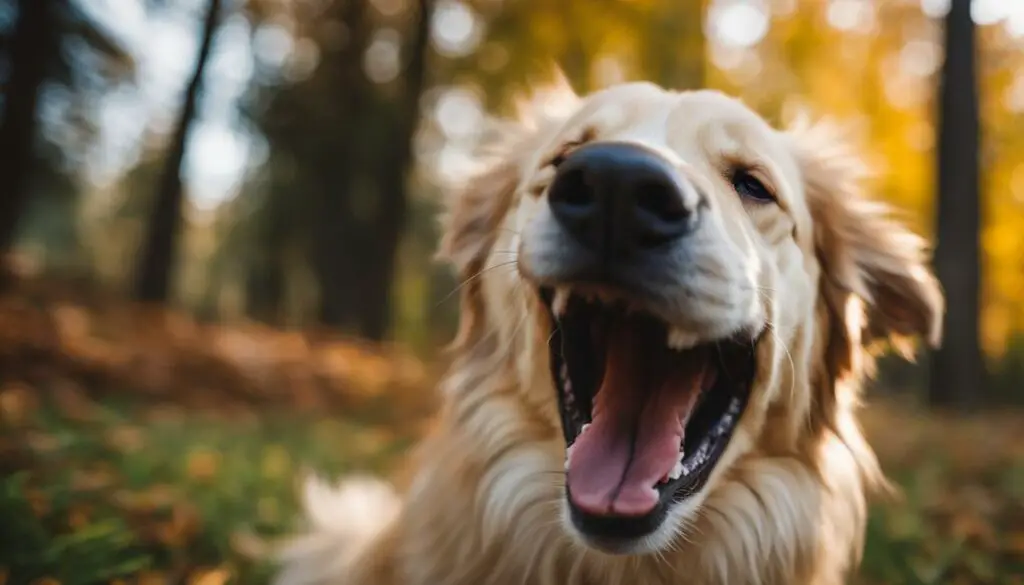
| Benefits of Dogs Yawning in Response to Owners | Examples |
|---|---|
| Enhances emotional connection | When you yawn, your dog yawns too, showing their emotional bond with you. |
| Strengthens the human-dog relationship | Yawning in response to each other fosters a sense of understanding and trust. |
| Indicates empathy | Your dog’s yawning demonstrates their ability to perceive and mirror your emotions. |
In conclusion, the phenomenon of dogs yawning in response to their owners is a testament to the deep emotional connection that exists between dogs and humans. It showcases the unique bond and level of empathy that dogs possess, further strengthening the relationship between them and their owners. So, the next time you yawn and your furry friend joins in, cherish this moment as a sign of the special connection you share.
Yawning and Confusion
Yawning in dogs can sometimes be a sign of confusion, particularly during training sessions. If your dog yawns when given a command, it may indicate that they don’t fully understand what you’re asking of them. This could be due to a variety of reasons, such as the command being too complex or the dog not being properly trained on that particular command. To address this confusion, it’s important to simplify the command and break it down into smaller, more manageable steps. By gradually increasing the difficulty level and providing clear and consistent cues, you can help your dog better comprehend and execute the desired behavior.
It’s also worth noting that confusion can arise if the training environment is noisy or distracting. Dogs are highly sensitive to their surroundings, and excessive noise or other distractions can make it challenging for them to focus and understand the command. In such cases, it’s beneficial to find a quiet and calm area for training, free from external disturbances. This will help minimize confusion and promote effective learning.

Yawning as a Calming Signal
Yawning in dogs is not only a sign of tiredness or excitement but also a powerful form of communication. Dogs use yawning as a calming signal, both with other dogs and sometimes with humans. Calming signals are behaviors used to convey a friendly attitude or request to stop certain activities. By yawning, dogs can indicate that they’re trying to maintain a peaceful and nonthreatening interaction.
When a dog yawns as a calming signal, it’s important to pay attention to the context in which it occurs. If a dog yawns during an interaction with another dog, it can mean that they want to deescalate the situation and avoid any potential conflict. Similarly, if a dog yawns when interacting with a human, it can be a way of expressing their desire for a calm and positive interaction.
In addition to yawning, dogs may also use other calming signals such as turning their head away, licking their lips, or sniffing the ground. These signals are all part of a dog’s body language and can help prevent misunderstandings and promote harmony in social interactions.
| Calming Signals in Dogs | Meaning |
|---|---|
| Yawning | Request for a peaceful interaction |
| Turning head away | Signal of non-aggression |
| Licking lips | Displacement behavior to release tension |
| Sniffing the ground | Non-confrontational behavior |
Understanding and respecting these calming signals can greatly enhance our communication with dogs and contribute to building positive relationships. When interacting with a dog, it’s important to be aware of their body language and respond accordingly. If a dog yawns or displays other calming signals, it’s best to give them space, reduce any potential stressors, and create a calm and safe environment for them.
Contagious Yawning in Dogs
Yawning is a natural phenomenon that is not limited to humans – dogs can also experience contagious yawning. Recent studies have shown that dogs are susceptible to yawning when they observe their owners or other dogs yawning, suggesting a certain level of empathy in dogs. Contagious yawning is often associated with empathy in humans, and this behavior in dogs further supports the idea that they are capable of understanding and mirroring the emotions of those around them.
When a dog yawns in response to seeing another dog or human yawn, it can be seen as a form of social bonding and communication. Dogs are highly perceptive animals, and they rely on visual cues and body language to interpret the world around them. Yawning can be a way for dogs to establish a sense of connection and empathy with their owners and fellow canines.
“Just like humans, dogs can also experience contagious yawning.”
This contagious yawning behavior in dogs can also be seen as a sign of trust and relaxation. When a dog feels comfortable and secure in their environment, they are more likely to engage in behaviors such as yawning in response to others. It is a reflection of their emotional well-being and the strong bond they have with their owners.
In conclusion, contagious yawning in dogs is a fascinating behavior that highlights their ability to empathize and connect with the emotions of those around them. It is a testament to the deep bond that can be formed between humans and their canine companions. By recognizing and appreciating this behavior, we can further enhance our understanding and communication with our beloved dogs.

Understanding Your Dog’s Yawns: Tips and Insights
Interpreting your dog’s yawns requires careful observation of their overall body language and considering the context in which the yawning occurs. Yawning in dogs can serve different purposes and convey various emotions, so it’s essential to pay attention to other cues as well. Here are some insights and tips to help you better understand your dog’s yawning behavior:
Observing Body Language
When trying to interpret your dog’s yawns, it’s crucial to observe their entire body language. Look for other signs such as eye contact, tail position, and ear position. These cues can provide valuable context and help you decipher the meaning behind the yawns. For example, if your dog yawns while avoiding eye contact and tucking their tail, it may indicate anxiety or fear.
Context is Key
Consider the situation in which your dog yawns. Is it during a specific activity or in response to a particular stimulus? Yawning can have different meanings depending on the context. For instance, if your dog yawns before going for a walk or engaging in playtime, it’s likely a sign of excitement and anticipation. On the other hand, yawning in stressful situations, such as during a visit to the vet, may indicate anxiety or appeasement.
Keep an Eye on Patterns
Take note of any patterns or frequency in your dog’s yawning behavior. Does it occur more often in certain situations or when exposed to specific triggers? Identifying patterns can help you pinpoint the underlying emotions or needs associated with the yawning. If you notice that your dog yawns frequently during car rides, it could be a sign of motion sickness or anxiety related to traveling.
| Yawning Behavior | Possible Interpretation |
|---|---|
| Accompanied by relaxed body language | Indicates tiredness or contentment |
| Accompanied by avoidance of eye contact | Suggests anxiety or fear |
| Preceded by increased panting and whining | Sign of stress or discomfort |
Remember, each dog is unique, and their yawning behavior may vary. It’s essential to consider your dog’s individual personality, history, and overall well-being when interpreting their yawns. By paying close attention to their body language, context, and patterns, you can develop a deeper understanding of your furry friend and strengthen your bond.

Enhancing Communication with Your Dog
Improving communication with your dog is essential for strengthening the human-dog bond. By understanding your dog’s behavior and body language, you can establish a deeper connection and create a harmonious relationship. Here are some tips to enhance communication with your furry friend:
1. Pay attention to body language:
Observe your dog’s body language, including their facial expressions, tail position, and posture. These cues can provide valuable insights into their emotions and intentions. For example, a wagging tail may indicate happiness, while a lowered head and tucked tail may suggest fear or anxiety.
2. Use positive reinforcement:
Positive reinforcement is a powerful tool for effective communication with your dog. Reward desired behaviors with treats, praise, and playtime to encourage them to repeat those behaviors. This positive approach fosters trust, builds confidence, and strengthens the bond between you and your dog.
3. Establish clear boundaries:
Setting clear boundaries and consistent rules helps establish a mutual understanding between you and your dog. Consistency in your expectations and responses will help your dog understand what is expected of them and promote better communication.
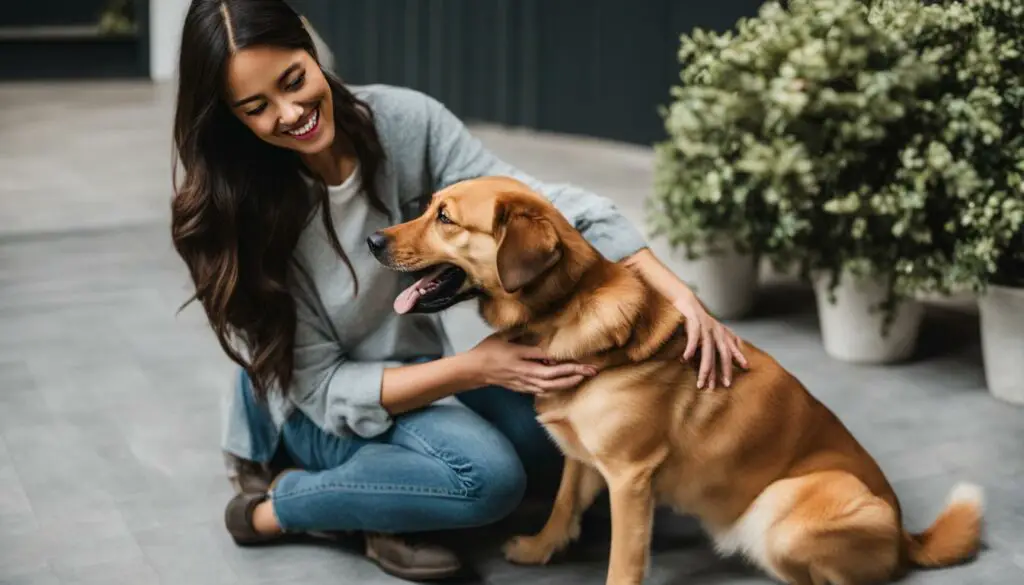
4. Practice active listening:
Being an active listener means paying attention to your dog’s needs and cues. By understanding their body language and responding appropriately, you can address their needs effectively and build trust. This active listening will strengthen the bond between you and your dog.
By following these tips, you can enhance communication with your dog and strengthen the human-dog bond. Remember, every dog is unique, so take the time to understand their individual preferences and communication style. Through patience, empathy, and clear communication, you and your furry friend can enjoy a lifelong partnership filled with love and understanding.
Professional Help and Health Concerns
While yawning is generally a normal behavior in dogs, excessive or abnormal yawning may be a cause for concern. If you notice your dog yawning excessively or displaying other unusual behaviors along with yawning, it’s important to consult a veterinarian to rule out any underlying health issues.
Yawning can sometimes be a sign of discomfort or pain in dogs. It could indicate respiratory problems, dental issues, or even a foreign object lodged in your dog’s throat. A veterinarian will be able to conduct a thorough examination, including a physical evaluation and any necessary diagnostic tests, to determine the cause of your dog’s excessive yawning.
In addition, if your dog’s yawning is accompanied by other symptoms such as coughing, sneezing, difficulty breathing, or changes in appetite or energy levels, it may be indicative of an underlying health condition. A veterinarian can provide the appropriate treatment and guidance to ensure your dog’s health and well-being.
| Signs of Concern | Possible Causes |
|---|---|
| Excessive yawning | Respiratory problems, dental issues, foreign object lodged in throat |
| Yawning with coughing or sneezing | Respiratory infections, allergies, or other respiratory conditions |
| Yawning with difficulty breathing | Heart or lung conditions, airway obstruction |
| Yawning with changes in appetite or energy levels | Digestive disorders, metabolic conditions, hormonal imbalances |
It’s always better to be safe than sorry when it comes to your dog’s health. If you have any concerns about your dog’s yawning behavior, don’t hesitate to reach out to a veterinarian for professional advice and guidance.
A veterinarian will be able to provide you with the necessary information and support to ensure the well-being of your furry companion. They can help identify any underlying health issues and develop a treatment plan tailored to your dog’s specific needs. Remember, early detection and intervention can make a significant difference in the outcome of your dog’s health.
By seeking professional help when needed, you can keep your dog happy, healthy, and free from any discomfort or pain associated with excessive yawning.

Conclusion
In conclusion, understanding why your dog yawns can provide valuable insights into their behavior and emotions. Yawning in dogs can serve various purposes, such as indicating fatigue, appeasement, stress, excitement, confusion, or as a calming signal. By paying attention to your dog’s overall body language and context, you can interpret their yawning behavior more effectively.
Interpreting dog behavior requires careful observation of cues like eye contact, tail position, and ear position. By doing so, you can gain a better understanding of your dog’s emotional state and intentions. Improving communication with your dog is essential for strengthening the human-dog bond and creating a harmonious relationship.
However, if you have concerns about your dog’s yawning or suspect underlying health issues, it’s important to consult a veterinarian for professional advice and examination. They can rule out any potential health concerns and provide appropriate guidance. Remember, dogs have their unique way of expressing themselves, and understanding their body language is key to a strong and loving relationship.
FAQ
Why does my dog yawn in my face?
Dogs may yawn as a form of communication. It can indicate tiredness, appeasement, or stress. Understanding the reasons behind your dog’s yawning can help you interpret their behavior better.
What does yawning in dogs look like?
Yawning in dogs involves a wide-open jaw and a deep breath. Some dogs may also make a sound when they yawn, while others do it silently. Yawning can serve different purposes, such as indicating tiredness, signaling calming in stressful situations, or expressing appeasement.
Why do dogs yawn when they’re tired?
Dogs yawn when they’re tired, just like humans do. Yawning can be seen when a dog is waking up, falling asleep, or when they lay down. It’s a clear signal that they need rest.
Why do dogs yawn to alleviate stress?
Yawning can be a way for dogs to alleviate stress. They may yawn and avert their gaze when they feel threatened or anxious. It’s a form of appeasement gesture that signals they don’t want to engage in conflict.
When do dogs yawn in stressful situations?
Dogs may yawn more often in stressful situations, such as car rides or exposure to loud noises. The yawns may be accompanied by panting and whining. Identifying and addressing the sources of stress can help reduce yawning behavior.
Why do dogs yawn when they want to go to bed?
Yawning can be a signal that your dog wants to go to bed but cannot do so because someone is in their sleep space. Providing your dog with a quiet, safe space of their own is important for their well-being.
When do dogs yawn in anxiety-inducing situations?
Yawning may occur in situations that cause anxiety for your dog, such as witnessing conflict or being scolded. Identifying the triggers that cause anxiety and avoiding exposure to those situations can help minimize yawning and promote a more relaxed state of mind.
Why do dogs yawn when they’re excited?
Yawning can indicate excitement and anticipation in dogs. When your dog yawns before a walk or during playtime, it shows their enthusiasm for the upcoming activity. They may be preparing their body for action by increasing oxygen flow and heart rate.
Why do dogs yawn when their owners yawn?
Dogs can feel empathy and have an emotional connection with their owners. They may yawn in response to their owners yawning as a sign of emotional closeness.
Why do dogs yawn during training sessions?
Yawning can indicate confusion in dogs during training sessions. If your dog yawns when given a command, it may signal that they don’t understand what you’re asking of them. Simplifying the command or moving on to a known command can help alleviate confusion and improve training effectiveness.
Why do dogs use yawning as a calming signal?
Dogs use yawning as a calming signal to convey a friendly attitude or request to stop certain activities. By yawning, dogs can indicate that they’re trying to maintain a peaceful and nonthreatening interaction.
Do dogs experience contagious yawning?
Yes, dogs are susceptible to contagious yawning. They may yawn when they observe their owners or other dogs yawning, suggesting a certain level of empathy in dogs.
How can I interpret my dog’s yawns?
Interpreting your dog’s yawns requires careful observation of their overall body language and considering the context. Pay attention to cues such as eye contact, tail position, and ear position to better understand their emotions and intentions.
How can I enhance communication with my dog?
Understanding why your dog yawns can improve communication and strengthen the bond between you and your canine companion. By being attentive to their yawning behavior and other body language cues, you can better meet their needs and create a harmonious relationship.
What should I do if I’m concerned about my dog’s yawning?
If you’re concerned about your dog’s yawning or suspect underlying health issues, it’s best to consult a veterinarian. They can provide professional advice and conduct a thorough examination to rule out any potential health concerns.
Source Links
- https://petcube.com/blog/what-dogs-yawn-means/
- https://www.thesprucepets.com/why-do-dogs-yawn-1118228
- https://iheartdogs.com/5-reasons-dogs-yawn-when-theyre-not-tired/








